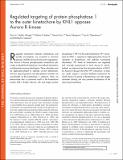Regulated targeting of protein phosphatase 1 to the outer kinetochore by KNL1 opposes Aurora B kinase
Author(s)
Liu, Dan; Vleugel, Mathijs; Backer, Chelsea B.; Hori, Tetsuya; Fukagawa, Tatsuo; Lampson, Michael A.; Cheeseman, Iain M; ... Show more Show less
DownloadLiu-2010-Regulated targeting.pdf (6.729Mb)
PUBLISHER_POLICY
Publisher Policy
Article is made available in accordance with the publisher's policy and may be subject to US copyright law. Please refer to the publisher's site for terms of use.
Terms of use
Metadata
Show full item recordAbstract
Regulated interactions between kinetochores and spindle microtubules are essential to maintain genomic stability during chromosome segregation. The Aurora B kinase phosphorylates kinetochore substrates to destabilize kinetochore–microtubule interactions and eliminate incorrect attachments. These substrates must be dephosphorylated to stabilize correct attachments, but how opposing kinase and phosphatase activities are coordinated at the kinetochore is unknown. Here, we demonstrate that a conserved motif in the kinetochore protein KNL1 directly interacts with and targets protein phosphatase 1 (PP1) to the outer kinetochore. PP1 recruitment by KNL1 is required to dephosphorylate Aurora B substrates at kinetochores and stabilize microtubule attachments. PP1 levels at kinetochores are regulated and inversely proportional to local Aurora B activity. Indeed, we demonstrate that phosphorylation of KNL1 by Aurora B disrupts the KNL1–PP1 interaction. In total, our results support a positive feedback mechanism by which Aurora B activity at kinetochores not only targets substrates directly, but also prevents localization of the opposing phosphatase.
Date issued
2010-03Department
Massachusetts Institute of Technology. Department of Biology; Whitehead Institute for Biomedical ResearchJournal
Journal of Cell Biology
Publisher
Rockefeller University Press
Citation
Liu, Dan et al. “Regulated targeting of protein phosphatase 1 to the outer kinetochore by KNL1 opposes Aurora B kinase.” The Journal of Cell Biology 188.6 (2010): 809 -820.
Version: Final published version
ISSN
0021-9525
1540-8140